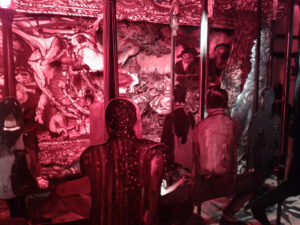In only one day, we could not possibly hope to see everything at the 2019 Venice Biennale but we walked through the Arsenal and the Gardini Gardens and managed to look at more than 30 exhibitions (there are at least 30 pavilions of nations.) Amongst several very good and memorable pavilions, the Russian exhibition stood out as far superior. It is set on two levels of the Russian exhibition Hall and is curated by Hermitage personnel and comprises ideas from some of the themes central to the art found in the world-renowned Hermitage Museum. A cast of the legs of Atlantis, a copy of a self-portrait by Rembrandt, an etching and two sculptures based upon Rembrandt’s “The Return of the Prodigal Son”, and copies of paintings from the Flemish School. The impact of Rembrandt’s sculptures is enhanced by surrounding mirrors which project the image in changed and twisted forms again and again, the meaning symbolic of a torn world that might be healed by forgiveness. The installation is designed by the celebrated film director Alexander Sokurov and showcases the turmoil of war that lies beyond its walls. As we headed down to the lower floor connected by a walkway to the upper hall, we became bathed in intense red light.

This exhibition highlights the Hermitage and its tie to the Flemish School of painting. Here we encountered copies of Fish market by Frans Snyders, which deals with the subject of sacrifice, the Bean King by Jacob Jordans, concerning a feast during a time of plague, a falsely appointed King and the New Market in Amsterdam by Bartholomeus van der Hels, depicts children, an elderly woman, vegetables, and lurid meats and has the feeling of a crucifixion scene. The Hermitage houses these three most popular paintings of Flemish daily life painted around the 16th century, and these pictures drew viewers from all over the world. In this gallery, they were copied in black outlines with red background on simple plywood by artist Alexander Shishkin-Hakusai. They are highlighted by a mobile installation with many outlines of almost life-sized human figures running up and down which are moved by mechanical cables. According to a guide of the pavilion, the red colour is symbolic of Jesus’s blood and the wine in the form of the Eucharist and is used to reflect the inner meaning of these three chosen paintings. The contrasting noise and speed made by members of the public riding on a Merry-go-Round emphasized the nature of consumption and the conflict between the museum as a scientific/cultural institution and the entertainment space alongside it. Nowadays, it often seems as if materialism has replaced the fundamental purpose of museums and this is surely a subject that all art institutions should be thinking about.
Lily Lihting Li Kostrzewa
